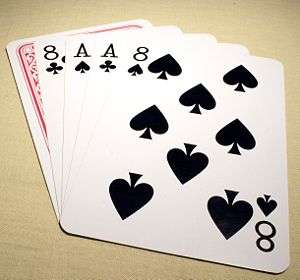Dead man's hand

The makeup of poker's dead man's hand has varied through the years. Currently, the dead man's hand is described as a two-pair poker hand consisting of the black aces and black eights. Along with an unknown "hole" card, these were the cards reportedly held by "Old West" folk hero, lawman and gunfighter, Wild Bill Hickok when he was murdered.
Earliest details
The expression "dead man's hand" appears to have had some currency in the late 19th and early 20th centuries, although no one connected it to Hickok until the 1920s.[1] The earliest detailed reference to the "dead man's hand" was 1886, where it was described as a "full house consisting of three jacks and a pair of tens".[2] Jacks and sevens are called the 'dead man's hand' in the 1903 Encyclopaedia of Superstitions, Folklore, and the Occult Sciences.[3] Edmond Hoyle references the Dead Man's Hand as "Jacks and eights" in 1907.[4]
Hickok's hand
What is considered the dead man's hand card combination of today gets its notoriety from a legend that it was the five-card stud hand held by James Butler Hickok (better known as "Wild Bill" Hickok) when he was shot in the back of the head by Jack McCall on August 2, 1876, in Nuttal & Mann's Saloon at Deadwood, Dakota Territory. Reportedly, Hickok's final hand included the aces and eights of both black suits.[5]
The make-up
According to a book by Western historian Carl W. Breihan, the cards were retrieved from the floor by a man named Neil Christy, who then passed them on to his son. The son, in turn, told Mr. Breihan of the composition of the hand: "Here is an exact identity of these cards as told to me by Christy's son: the ace of diamonds with a heel mark on it; the ace of clubs; the two black eights, clubs and spades, and the queen of hearts with a small drop of Hickock's blood on it."[6]
Hickok biographer Joseph Rosa wrote about the make-up of the hand: "The accepted version is that the cards were the ace of spades, the ace of clubs, two black eights [clubs and spades], and the queen of clubs as the 'kicker' [card]."[7] However, Rosa said no contemporaneous source for this exact hand can be found.[8] The solidification in gamers parlance of the dead man's hand as two pair, "aces and eights", didn't come about until after the 1926 publication of Frank Wilstach's book, Wild Bill Hickok: The Prince of Pistoleers—50 years after Hickok's death.[1]
The western-themed collectible card game, Doomtown (and its rebooted expandable card game, Doomtown: Reloaded), uses the Dead Man's Hand as the highest rank in the game, and uses the Jack of Diamonds as the fifth card.[9]
Legacy
The Las Vegas Metropolitan Police Department Homicide Division, the Los Angeles Police Department CRASH squad, and the Armed Forces Medical Examiner System are some organizations which use the dead man's hand in their insignia.[10][11]
See also
References
- 1 2 "Was Wild Bill Hickok Holding the Dead Mans Hand When He Was Slain; The Straight Dope article; retrieved March 2013.
- ↑ Discussion; July 3, 1886, article in the Grand Forks Daily Herald; at Linguist List online; retrieved February 2013.
- ↑ Cora Linn Morrison Daniels, et al; editor; Volume 2.
- ↑ Edmond Hoyle; Hoyle's Games; 1907; p. 405
- ↑ Wild Bill Hickok: The Prince of Pistoleers; Frank J. Wilstach; 1926.
- ↑ Wild Women of the West; Signet; 1982; p. 77.
- ↑ Wild Bill Hickok: Gunfighter; Joseph G. Rosa; p. 163.
- ↑ Wild Bill Hickok: The Man and his Myth; Joseph Rosa; 1996.
- ↑ , Doomtown: Reloaded Rules o' Play, Alderac Entertainment Group, 2014.
- ↑ "Las Vegas Metropolitan Police Department". Archived from the original on 16 March 2015. Retrieved 20 March 2015.
- ↑ "Office of the Armed Forces Medical Examiner". Archived from the original on 15 May 2012. Retrieved 20 March 2015.